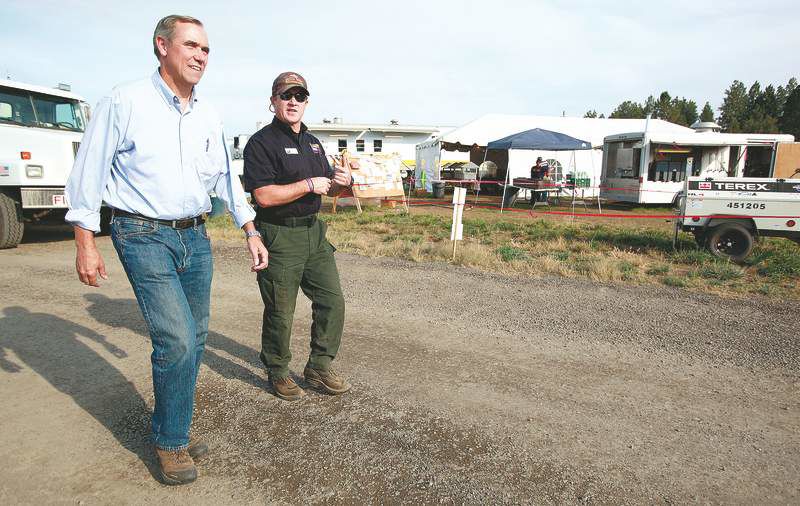A long, hard summer for firefighters
Published 5:00 am Saturday, September 29, 2012

- U.S. Sen. Jeff Merkley gets a tour of the Pole Creek Fire fire camp at the Sisters Rodeo Grounds on Friday with Incident Commander Brian Watts. Merkley was in Sisters to meet with firefighters who have been battling the Pole Creek Fire southwest of town.
Fire season for Oregon Incident Management Team 4 started in mid-July with the Long Draw Fire in southeast Oregon and ends today as it passes command of the Pole Creek Fire back to local fire officials.
“It’s been a long season,” Brian Watts, the incident commander, said early this week.
The team worked five wildfires this year, including some of the most notable in the state: the Long Draw, Miller Homestead, Barry Point, Parrish Cabin and Pole Creek fires.
A fast-moving grass fire, the Long Draw burned 557,648 acres — 871 square miles — of rangeland.
The largest fire in Central Oregon this year, the Pole Creek Fire had burned 26,285 acres, or 41 square miles, southwest of Sisters as of Friday and was 85 percent contained. The Pole Creek Fire is expected to be fully contained Oct. 15. Its cause is still under investigation.
Watts said the fires were similar. They were complex and had the tendency to spread rapidly.
“The hot weather, windy conditions (were) really causing the fires to grow,” he said.
Trials by fire
Watts, a fire ecologist for the Bureau of Land Management Vale’s District when not in a fire camp, has been fighting wildfires for more than 20 years. Although he is a veteran of firefighting leadership teams, this was Watts’ first year in charge, and the Long Draw fire was his first fire.
“It went 300,000 acres on our first shift,” he said.
A more experienced fire management group relieved Team 4 after a second 24-hour shift on the Long Draw, as the fire continued to spread. In early August, the team was also replaced by a more experienced team after nine days of leading the fight of the 93,071-acre Barry Point Fire near Lakeview. The fire had burned into California and was still growing.
Such shuffling of teams is common in the world of federal firefighting. Formerly called the Blue Mountain Interagency Incident Management Team, Team 4 is a type II outfit. That puts the 50-member group between the elite type I teams and smaller type III teams in the hierarchy of fire command, which the U.S. Forest Service and other federal agencies modeled after the military.
“It wasn’t that we failed,” Watts said.
And what the team learned from the fast-spreading fires earlier this summer was invaluable once it was on the Pole Creek Fire, he said.
The fire started on Sept. 9 and Team 4 took command at 8 p.m. the next day. From the beginning Watts said the team braced for the fire to blow up. The focus was to stop it from moving toward Sisters, onto private land or into the Bend watershed.
On Sept. 14, the fire grew from about 6,000 to nearly 15,000 acres. Despite the growth, the fire was still away from town, private land and the watershed. The spread has been mainly into the Three Sisters Wilderness Area, where Watts said snags pose a falling threat to firefighters so they’re not aggressively fighting it.
As it moves toward the Three Sisters, the fire is also running out of material to burn the higher up the slope it goes.
“It is burning into rocks or vegetation that doesn’t want to burn,” Watts said.
‘Had it all’
The Pole Creek Fire was also the first major blaze for Kristie Miller as district ranger for the Sisters Ranger District of the Deschutes National Forest. Miller took over the post in early May after Bill Anthony retired after 14 years.
Having worked for the Forest Service for 37 years, Miller said she managed wildfires on the Willamette and Gifford Pinchot national forests, but none was the size or complexity of the Pole Creek Fire.
“This one had it all,” she said.
Like Watts, she listed the threat it posed to homes, private land and the watershed.
Miller said she met with Team 4 nearly every day since the fire started, and its members were responsive to how the Deschutes National Forest leaders wanted the fire managed.
Dangerous occupation
At public meetings in Sisters over the past month, members of Team 4 and forest officials stressed that they think about the safety of firefighters with every decision they make.
Watts, 44, said he personally knows the pain of losing fellow firefighters. A Burns native, he started as a seasonal federal firefighter in 1988 in his hometown and worked up through the ranks.
Friends with the Prineville Hot Shots — Tamera Bickett and Levi Brinkley — were killed in 1994 by the South Canyon Fire on Storm King Mountain in Colorado.
A shift in wind pushed the fire uphill, killing Bickett, Brinkley and 12 other firefighters, according to an online Oregon memorial to them. Investigators determined that the crews didn’t follow safety procedures in fighting the fire.
Watts said he has read all he can find about Storm King and has visited a memorial on the mountainside. The deaths caused him to think about consequences before taking action.
“This isn’t a game,” he said. “It’s a dangerous occupation.”
And a time-consuming one during the fire season.
Team 4 had one day off after the 6,481-acre Parish Cabin near John Day before starting 20 days in charge of the Pole Creek Fire. Now it’s headed home.
“I’m ready for some time off,” Watts said.





